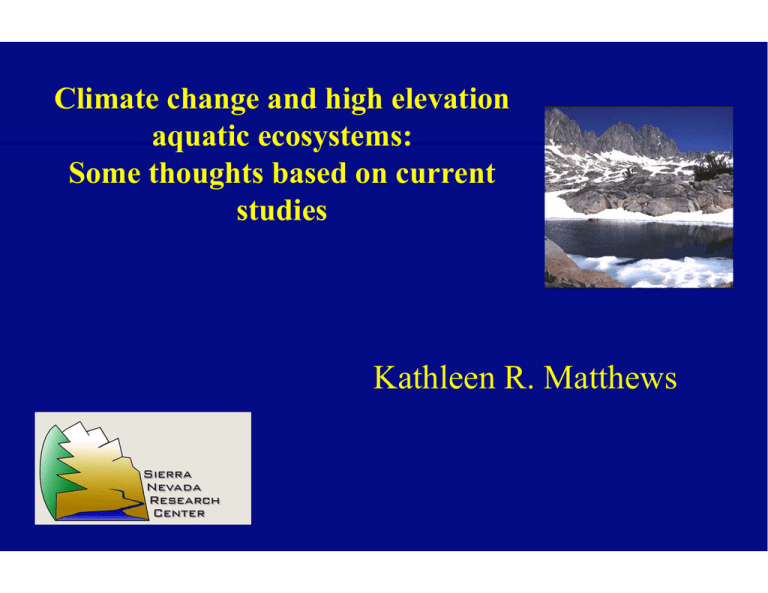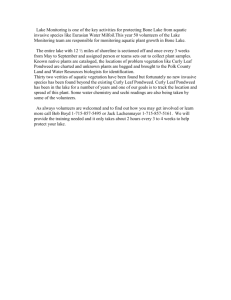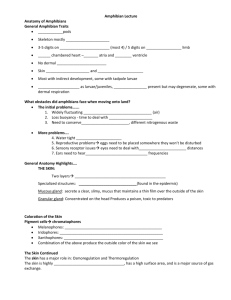Climate Change and High Elevation Aquatic Ecosystems: Some thoughts based on current studies
advertisement

Climate change and high elevation aquatic ecosystems: Some thoughts based on current studies Kathleen R. Matthews Sierra Nevada High Mountain Lakes >10,000 lakes & ponds above 2500 m Water level depends on snowpack & summer thunderstorms Primarily found in Wilderness on federal lands Typically small (<10 ha), shallow (<10 m), and clear Most (99%) historically fishless Native aquatic species include amphibians, garter snake, zooplankton What changes are predicted for high elevations in the Sierra Nevada if warming occurs? More precipitation during winter-bigger snowpack Longer winter More precipitation during the summer from tropical storms How might the changes affect high elevation aquatic organisms? Rana muscosa in the Sierra Nevada Endemic to high elevation Sierra Nevada Have declined throughout most of its range Warranted for federal listing Adults are highly aquatic & tadpoles overwinter 3-4 years before metamorphosis into adults Recent surveys show most breeding occurs in shallow ponds that freeze in winter and sometimes disappear in summer if precipitation is low Other high elevation amphibians Hyla regilla & Bufo canorus- adults more terrestrial & one year tadpole phase Interaction between amphibians—condition of Rana muscosa increases when they are found with high numbers of Hyla tadpoles Possibly influenced more by length of summer and air/water temperature Rana muscosa Condition Garter snakes Thamnopis elegans elegans Only snake found in the High Sierra Highly aquatic and an amphibian predator Snakes are most numerous in areas with higher abundance of amphibians, and snakes have disappeared in areas with amphibian declines Their abundance & distribution will be affected by amphibian changes 2003 2002 2001 2000 1999 1998 1997 1996 1995 1994 1993 1992 1991 1990 1989 Inches Bishop Pass Snow Water Content, 1989-2003 60 50 40 30 20 10 0 20 10 0 0 5 /1 4 /1 3 /1 2 /1 1 /1 9 /1 10 9 /1 20 8 /1 30 8 /1 40 7 /1 50 7 /1 60 6 /1 Snowpack, 00-01 6 /1 5 /1 30 4 /1 40 3 /1 Snowpack, 99-00 2 /1 60 1 /1 0 1 2 /1 10 1 2 /1 20 1 1 /1 30 1 0 /1 40 W a te r c o n te n t i n i n c h e s 50 1 1 /1 50 W a te r c o n te n t i n i n c h e s 9 /1 8 /1 7 /1 6 /1 5 /1 4 /1 3 /1 2 /1 1 /1 1 2 /1 1 1 /1 1 0 /1 W a te r c o n te n t i n i n c h e s 60 1 0 /1 9 /1 8 /1 7 /1 6 /1 5 /1 4 /1 3 /1 2 /1 1 /1 1 2 /1 1 1 /1 1 0 /1 W a t e r c o n t e n t in in c h e s Snowpack 97-98 Snowpack, 98-99 60 50 40 30 20 10 0 9 /2 9 9 /2 2 9 /1 5 9 /8 9 /1 8 /2 5 8 /1 8 8 /1 1 8 /4 7 /2 8 7 /2 1 7 /1 4 7 /7 6 /3 0 A c c u m u la t io n ( in c h e s ) Dusy Basin Rain, 2000-2003 5 2003 4 3 2001 2 1 2000 2002 0 PSW aquatic research in high-elevation lakes Role of introduced trout on native aquatic organisms Use GIS & 3-D mapping to determine: Changes in habitat availability and water volume Using tagging and count surveys on amphibians and reptiles, determine factors contributing to: survival growth movement site fidelity Dusy Basin: Overview Map 30. 2 5 6 2 11 30. 1 4 31 10 1 9 7 8 3 33 Maximum depth & 1998 egg mass locations in Dusy Basin study lakes Number egg masses Max. depth (m) 12 10 8 6 4 2 0 1 2 3 4 Lake number 5 6 7 100 90 80 70 60 50 40 30 20 10 0 1 2 3 4 5 Lake number 6 7 Lake 5 Fall 1997 ~1,000 R muscosa tadpoles. Pond at capacity. July 1998 177% normal snowfall in 97/98 winter. ~80% R. muscosa tadpoles survived Lake 2 July 1999 • 4,000 R. muscosa tadpoles (1st-3rd yr) September 1999 • No tadpole survival Lake 5 Fall 1999 Over 1,000 tadpoles (1st – 3rd yr) ~ 10% survival to 2000 Fall 2000 ~ 200 tadpoles (mostly 1st yr) Lake 5: Bathymetry Lake 5: Volume Change 7/05/2002 V:276.7m3 A: 819 m2 7/28/2002 V:203.7m3 A: 603 m2 8/15/2002 V:140.8m3 A: 323 m2 Can we make predictions about climate change by looking at responses of aquatic communities to current extremes in precipitation? Determine populations responses to the current climate variability Quantify responses of aquatic species to changes in precipitation, water volume, lake drying, etc. Develop models to determine important climate variables influencing amphibian and reptile populations, and make predictions for future climate changes





